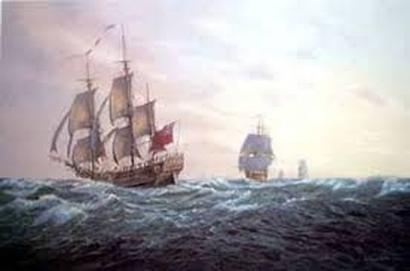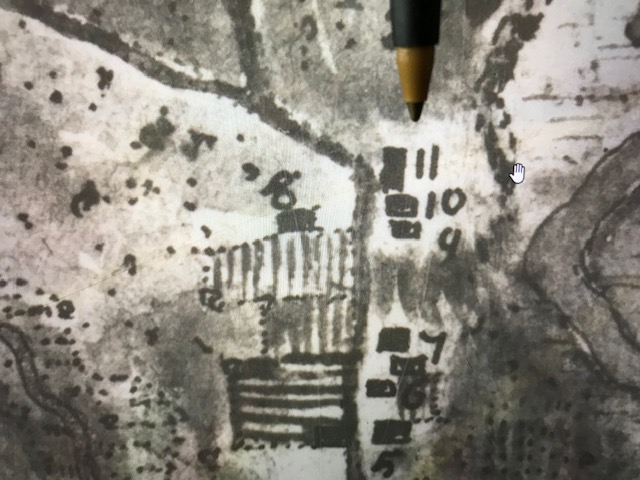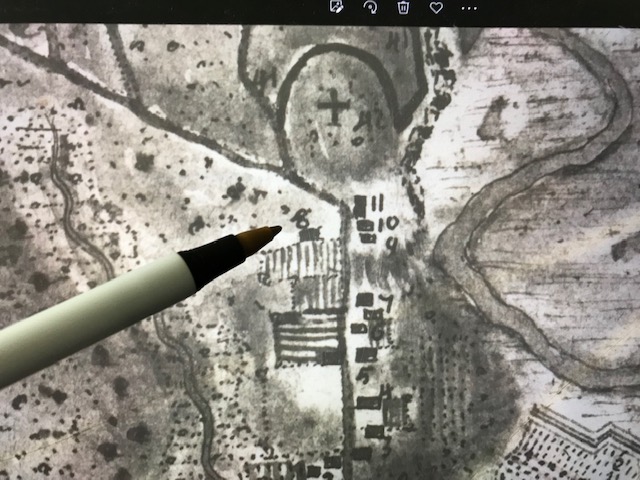In memory of the tragic events of December 8th, 1755 - En mémoire des événements tragiques du 8 décembre 1755

THE SEIZURE OF “THE PEMBROKE” BY THE ACADIANS
Article written by: Yarmouth Vanguard, Tuesday, January 23, 1990
There have been several seizures or attempts of seizures by the Acadians of vessels taking them into exile. In the accounts which have come down to us, tradition has at times confused one for the other. The best known of these seizures is that of the Pembroke. Its most reliable account comes from Placide Gaudet, the well known Acadian genealogist, who held it from a grandson of Pierre Belliveau, dit Piau, of Memramcook, this Pierre Belliveau being the brother of Charles Belliveau who conducted the seizure. I may note that they were brothers to Jean Belliveau, the ancestor of the Belliveaus of Belliveau’s Cove; they were the sons of another Jean Belliveau and of Madeleine Melanson, of Port Royal.
While the authorities were making plans to expel the Acadians, they requested the Pembrook, a scow, to come to Annapolis Royal to pick up the Acadians to bring them into exile. On its way, it encountered a storm and broke its mainmast. Charles Belliveau, who was a ship contractor and a skillful navigator, was summoned to replace the mast as soon as possible with a new one. When he asked for his pay, he was just laughed at. He then threatened to cut the mast, that which was enough for the authorities to give him the amount of money that had been agreed upon.
Little did he know then that a few weeks later he would have to embark on that very vessel to be taken into exile. It happened on December, 8, 1755, at 5 o’clock in the morning. They were 226 Acadians in all, men, women and children, comprising 32 families. They were heading for South Carolina.
The armed sloop Baltimore escorted them up to New York. When the Pembrook was left to sail on its own, the Acadian prisoners started to make plans to seize it. It happened that they were allowed to go on deck for a short while half a dozen at a time. Six of the most capable men having taken their turn on the deck, among whom was Charles Belliveau, they were told after a while to go down the hole, when six others were asked to take their place. Instead of going down, those six who were already on deck seized their guards, and, with the help of the six others who had already come up, plus a few more who followed, it did not take them long to bound all eight members of the crew, hand and foot, the captain included.
That is when Charles Belliveau took the wheel. As there was a down wind, the vessel was turned around easily and it headed back north. The captain, in his shackles, hollered that he was going to break the mainmast, because it was weak. Charles Belliveau answered that he was lying, that he, himself, had made it and set it and that it could withstand any wind forever.
They were steering for the St. John River, N.B. A few days before they arrived, they landed the captain and the crew on the shore, probably in Maine. Luckily, all the way, they did not encounter any ships or vessels. They arrived in St. John January 8, 1756, having been on the Pembrook exactly one month.
They had been about another month in the vicinity of St. John, when, on February 9, an English vessel anchored in St. John harbour, flying the French flag. They said that they were from Louisbourg and that they were looking for a pilot to anchor further up the harbour. Notwithstanding that it was a trap, one of the Acadians fell into it. He had hardly gotten aboard the English vessel, which in reality was coming from Annapolis Royal, that the captain hoisted the English ensign and fired his cannon.
The Acadian families, who at first had taken refuge near the mouth of the river, had been sent further up where they could be more secure. When they heard the cannon, they ran to see what was taking place. That is when they noticed that the English vessel was going toward the Pembrook, surely to get hold of it. They had time to take away from it the firearms and other objects which had been left in it. They then set it on fire and started to fire on the English vessel, which was obliged to leave.
Feb. 18, 1756, Governor Lawrence wrote from Halifax to Governor Shirley of Massachusetts: “I lately sent a party of Rangers in a schooner to St. John’s River. As the men were clothed like French soldiers and the schooner under French colours, I had hopes by such a deceit, not only to discover what it was doing there but to bring off some of the St. John’s Indians. The Officer found there an English Ship, one of our Transports that sailed from Annapolis Royal with French inhabitants aboard bound for the Continent, but the inhabitants had risen upon the master and crew and carried the ship into that harbour, our people would have brought her off but by an accident they discovered themselves too soon, upon which the French set fire to the ship. They have brought back with them one French man, who says there have been no Indians there for some time … he informs also that there is a French officer and about 20 men twenty-three miles up the river at place called St. Ann’s,” which was on the west side of what is now Fredericton. It could be that he informed Lawrence that those men were at 23 miles up the river to lead him purposely into error, because between St. John and Fredericton there are 85 miles.
Among other testimonies regarding this seizure, we have a letter dated July 31, 1756, from the “inhabitants of St. John River”, sent to Father Daudin, former pastor at Annapolis, in which they tell him that they “revolted without any defense from the English, took charge of the vessel and have arrived happily at St. John River, from where we write this letter.” Father Daudin did not see this letter, as he died suddenly in Paris the following month, while he was getting ready to return to Acadia.
Most of these Acadians who were on the Pembrook migrated to Quebec, where their descendants are still to be found.
Note: More information on this historical event can be found by clicking on the below websites
LA PRISE DE POSSESSION DU "PEMBROKE" PAR LES ACADIENS
Article ecrit par: Yarmouth Vanguard, mardi 23 janvier 1990
Il y a eu plusieurs saisies ou tentatives de saisies par les Acadiens de navires les emmenant en exil. Dans les récits qui nous sont parvenus, la tradition a parfois confondu l'un et l'autre. La plus connue de ces saisies est celle du Pembroke. Son récit le plus fiable nous vient de Placide Gaudet, le généalogiste acadien bien connu, qui le tient d'un petit-fils de Pierre Belliveau, dit Piau, de Memramcook, ce Pierre Belliveau étant le frère de Charles Belliveau qui a effectué la saisie. Je peux noter qu'ils étaient frères de Jean Belliveau, l'ancêtre des Belliveau de Belliveau's Cove ; ils étaient les fils d'un autre Jean Belliveau et de Madeleine Melanson, de Port Royal.
Alors que les autorités faisaient des plans pour expulser les Acadiens, elles ont demandé au Pembrook, un chaland, de venir à Annapolis Royal pour ramasser les Acadiens et les emmener en exil. En chemin, il a rencontré une tempête et a brisé son grand mât. Charles Belliveau, qui est entrepreneur de navires et habile navigateur, est sommé de remplacer le mât au plus vite par un nouveau. Lorsqu'il demanda son salaire, on se contenta de lui rire au nez. Il a alors menacé de couper le mât, ce qui a suffi pour que les autorités lui remettent la somme d'argent qui avait été convenue.
Il était alors loin de se douter que quelques semaines plus tard, il devrait embarquer sur ce même navire pour être emmené en exil. C'était le 8 décembre 1755, à 5 heures du matin. Ils étaient 226 Acadiens en tout, hommes, femmes et enfants, répartis en 32 familles. Ils se dirigent vers la Caroline du Sud.
Le sloop armé Baltimore les escorte jusqu'à New York. Lorsque le Pembrook a été laissé à lui-même, les prisonniers acadiens ont commencé à faire des plans pour s'en emparer. Il se trouve qu'on leur a permis de monter sur le pont pendant un court moment, une demi-douzaine à la fois. Six des hommes les plus capables ayant pris leur tour sur le pont, parmi lesquels se trouvait Charles Belliveau, on leur dit au bout d'un moment de descendre dans le trou, quand six autres furent priés de prendre leur place. Au lieu de descendre, les six qui étaient déjà sur le pont s'emparèrent de leurs gardes, et, avec l'aide des six autres qui étaient déjà montés, plus quelques autres qui suivirent, il ne leur fallut pas longtemps pour lier les huit membres de l'équipage, pieds et poings, le capitaine compris.
C'est alors que Charles Belliveau prend la barre. Comme il y a un vent arrière, le navire fait facilement demi-tour et repart vers le nord. Le capitaine, dans ses chaînes, a crié qu'il allait briser le grand mât, car il était faible. Charles Belliveau lui répondit qu'il mentait, que c'était lui qui l'avait fabriqué et réglé et qu'il pouvait résister à tout vent pour toujours.
Ils se dirigeaient vers la rivière Saint-Jean, au Nouveau-Brunswick. Quelques jours avant leur arrivée, ils ont débarqué le capitaine et l'équipage sur la rive, probablement dans le Maine. Heureusement, tout au long du trajet, ils n'ont rencontré aucun navire ou bateau. Ils sont arrivés à St-Jean le 8 janvier 1756, après avoir été sur le Pembrook exactement un mois.
Ils avaient passé environ un autre mois dans les environs de St. John, lorsque, le 9 février, un navire anglais a jeté l'ancre dans le port de St. John, battant pavillon français. Ils ont dit qu'ils venaient de Louisbourg et qu'ils cherchaient un pilote pour mouiller plus haut dans le port. Malgré le fait que c'était un piège, un des Acadiens y est tombé. Il était à peine monté à bord du navire anglais, qui en réalité venait d'Annapolis Royal, que le capitaine hissa le pavillon anglais et tira son canon.
Les familles acadiennes, qui s'étaient d'abord réfugiées près de l'embouchure de la rivière, avaient été envoyées plus haut où elles pouvaient être plus en sécurité. Lorsqu'elles ont entendu le canon, elles ont couru pour voir ce qui se passait. C'est alors qu'ils ont remarqué que le navire anglais se dirigeait vers le Pembrook, sûrement pour s'en emparer. Ils eurent le temps d'en retirer les armes à feu et autres objets qui y avaient été laissés. Ils y mirent ensuite le feu et commencèrent à tirer sur le vaisseau anglais, qui fut obligé de partir.
Le 18 février 1756, le gouverneur Lawrence écrit de Halifax au gouverneur Shirley du Massachusetts : " J'ai récemment envoyé un groupe de Rangers dans une goélette à la rivière Saint-Jean. Comme les hommes étaient vêtus comme des soldats français et que la goélette portait des couleurs françaises, j'espérais, par cette tromperie, non seulement découvrir ce qu'elle faisait là, mais aussi ramener quelques Indiens de St. L'officier a trouvé là un navire anglais, un de nos transports qui avait quitté Annapolis Royal avec des habitants français à bord en direction du continent, mais les habitants s'étaient levés sur le capitaine et l'équipage et avaient amené le navire dans ce port, nos gens l'auraient fait descendre mais par accident ils se sont découverts trop tôt, et les Français ont mis le feu au navire. Ils ont ramené avec eux un Français, qui dit qu'il n'y a plus d'Indiens depuis un certain temps ... il informe également qu'il y a un officier français et une vingtaine d'hommes vingt-trois ans plus tard.
Article ecrit par: Yarmouth Vanguard, mardi 23 janvier 1990
Il y a eu plusieurs saisies ou tentatives de saisies par les Acadiens de navires les emmenant en exil. Dans les récits qui nous sont parvenus, la tradition a parfois confondu l'un et l'autre. La plus connue de ces saisies est celle du Pembroke. Son récit le plus fiable nous vient de Placide Gaudet, le généalogiste acadien bien connu, qui le tient d'un petit-fils de Pierre Belliveau, dit Piau, de Memramcook, ce Pierre Belliveau étant le frère de Charles Belliveau qui a effectué la saisie. Je peux noter qu'ils étaient frères de Jean Belliveau, l'ancêtre des Belliveau de Belliveau's Cove ; ils étaient les fils d'un autre Jean Belliveau et de Madeleine Melanson, de Port Royal.
Alors que les autorités faisaient des plans pour expulser les Acadiens, elles ont demandé au Pembrook, un chaland, de venir à Annapolis Royal pour ramasser les Acadiens et les emmener en exil. En chemin, il a rencontré une tempête et a brisé son grand mât. Charles Belliveau, qui est entrepreneur de navires et habile navigateur, est sommé de remplacer le mât au plus vite par un nouveau. Lorsqu'il demanda son salaire, on se contenta de lui rire au nez. Il a alors menacé de couper le mât, ce qui a suffi pour que les autorités lui remettent la somme d'argent qui avait été convenue.
Il était alors loin de se douter que quelques semaines plus tard, il devrait embarquer sur ce même navire pour être emmené en exil. C'était le 8 décembre 1755, à 5 heures du matin. Ils étaient 226 Acadiens en tout, hommes, femmes et enfants, répartis en 32 familles. Ils se dirigent vers la Caroline du Sud.
Le sloop armé Baltimore les escorte jusqu'à New York. Lorsque le Pembrook a été laissé à lui-même, les prisonniers acadiens ont commencé à faire des plans pour s'en emparer. Il se trouve qu'on leur a permis de monter sur le pont pendant un court moment, une demi-douzaine à la fois. Six des hommes les plus capables ayant pris leur tour sur le pont, parmi lesquels se trouvait Charles Belliveau, on leur dit au bout d'un moment de descendre dans le trou, quand six autres furent priés de prendre leur place. Au lieu de descendre, les six qui étaient déjà sur le pont s'emparèrent de leurs gardes, et, avec l'aide des six autres qui étaient déjà montés, plus quelques autres qui suivirent, il ne leur fallut pas longtemps pour lier les huit membres de l'équipage, pieds et poings, le capitaine compris.
C'est alors que Charles Belliveau prend la barre. Comme il y a un vent arrière, le navire fait facilement demi-tour et repart vers le nord. Le capitaine, dans ses chaînes, a crié qu'il allait briser le grand mât, car il était faible. Charles Belliveau lui répondit qu'il mentait, que c'était lui qui l'avait fabriqué et réglé et qu'il pouvait résister à tout vent pour toujours.
Ils se dirigeaient vers la rivière Saint-Jean, au Nouveau-Brunswick. Quelques jours avant leur arrivée, ils ont débarqué le capitaine et l'équipage sur la rive, probablement dans le Maine. Heureusement, tout au long du trajet, ils n'ont rencontré aucun navire ou bateau. Ils sont arrivés à St-Jean le 8 janvier 1756, après avoir été sur le Pembrook exactement un mois.
Ils avaient passé environ un autre mois dans les environs de St. John, lorsque, le 9 février, un navire anglais a jeté l'ancre dans le port de St. John, battant pavillon français. Ils ont dit qu'ils venaient de Louisbourg et qu'ils cherchaient un pilote pour mouiller plus haut dans le port. Malgré le fait que c'était un piège, un des Acadiens y est tombé. Il était à peine monté à bord du navire anglais, qui en réalité venait d'Annapolis Royal, que le capitaine hissa le pavillon anglais et tira son canon.
Les familles acadiennes, qui s'étaient d'abord réfugiées près de l'embouchure de la rivière, avaient été envoyées plus haut où elles pouvaient être plus en sécurité. Lorsqu'elles ont entendu le canon, elles ont couru pour voir ce qui se passait. C'est alors qu'ils ont remarqué que le navire anglais se dirigeait vers le Pembrook, sûrement pour s'en emparer. Ils eurent le temps d'en retirer les armes à feu et autres objets qui y avaient été laissés. Ils y mirent ensuite le feu et commencèrent à tirer sur le vaisseau anglais, qui fut obligé de partir.
Le 18 février 1756, le gouverneur Lawrence écrit de Halifax au gouverneur Shirley du Massachusetts : " J'ai récemment envoyé un groupe de Rangers dans une goélette à la rivière Saint-Jean. Comme les hommes étaient vêtus comme des soldats français et que la goélette portait des couleurs françaises, j'espérais, par cette tromperie, non seulement découvrir ce qu'elle faisait là, mais aussi ramener quelques Indiens de St. L'officier a trouvé là un navire anglais, un de nos transports qui avait quitté Annapolis Royal avec des habitants français à bord en direction du continent, mais les habitants s'étaient levés sur le capitaine et l'équipage et avaient amené le navire dans ce port, nos gens l'auraient fait descendre mais par accident ils se sont découverts trop tôt, et les Français ont mis le feu au navire. Ils ont ramené avec eux un Français, qui dit qu'il n'y a plus d'Indiens depuis un certain temps ... il informe également qu'il y a un officier français et une vingtaine d'hommes vingt-trois ans plus tard.
Note : Vous trouverez de plus amples informations sur cet événement historique en cliquant sur les sites web suivants:
Translated in Fench by using Deepl.Pro




